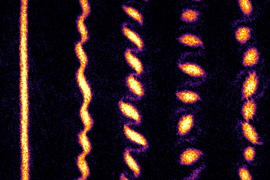The world we experience is governed by classical physics. How we move, where we are, and how fast we’re going are all determined by the classical assumption that we can only exist in one place at any one moment in time.
But in the quantum world, the behavior of individual atoms is governed by the eerie principle that a particle’s location is a probability. An atom, for instance, has a certain chance of being in one location and another chance of being at another location, at the same exact time.
When particles interact, purely as a consequence of these quantum effects, a host of odd phenomena should ensue. But observing such purely quantum mechanical behavior of interacting particles amid the overwhelming noise of the classical world is a tricky undertaking.
Now, MIT physicists have directly observed the interplay of interactions and quantum mechanics in a particular state of matter: a spinning fluid of ultracold atoms. Researchers have predicted that, in a rotating fluid, interactions will dominate and drive the particles to exhibit exotic, never-before-seen behaviors.
In a study published today in Nature, the MIT team has rapidly rotated a quantum fluid of ultracold atoms. They watched as the initially round cloud of atoms first deformed into a thin, needle-like structure. Then, at the point when classical effects should be suppressed, leaving solely interactions and quantum laws to dominate the atoms’ behavior, the needle spontaneously broke into a crystalline pattern, resembling a string of miniature, quantum tornadoes.
“This crystallization is driven purely by interactions, and tells us we’re going from the classical world to the quantum world,” says Richard Fletcher, assistant professor of physics at MIT.
The results are the first direct, in-situ documentation of the evolution of a rapidly-rotating quantum gas. Martin Zwierlein, the Thomas A. Frank Professor of Physics at MIT, says the evolution of the spinning atoms is broadly similar to how Earth’s rotation spins up large-scale weather patterns.
“The Coriolis effect that explains Earth’s rotational effect is similar to the Lorentz force that explains how charged particles behave in a magnetic field,” Zwierlein notes. “Even in classical physics, this gives rise to intriguing pattern formation, like clouds wrapping around the Earth in beautiful spiral motions. And now we can study this in the quantum world.”
The study’s coauthors include Biswaroop Mukherjee, Airlia Shaffer, Parth B. Patel, Zhenjie Yan, Cedric Wilson, and Valentin Crépel, who are all affiliated with the MIT-Harvard Center for Ultracold Atoms and MIT’s Research Laboratory of Electronics.
Spinning stand-ins
In the 1980s, physicists began observing a new family of matter known as quantum Hall fluids, which consists of clouds of electrons floating in magnetic fields. Instead of repelling each other and forming a crystal, as classical physics would predict, the particles adjusted their behavior to what their neighbors were doing, in a correlated, quantum way.
“People discovered all kinds of amazing properties, and the reason was, in a magnetic field, electrons are (classically) frozen in place — all their kinetic energy is switched off, and what’s left is purely interactions,” Fletcher says. “So, this whole world emerged. But it was extremely hard to observe and understand.”
In particular, electrons in a magnetic field move in very small motions that are hard to see. Zwierlein and his colleagues reasoned that, as the motion of atoms under rotation occurs at much larger length scales, they might be able to use ultracold atoms as stand-ins for electrons, and be able to watch identical physics.
“We thought, let’s get these cold atoms to behave as if they were electrons in a magnetic field, but that we could control precisely,” Zwierlein says. “Then we can visualize what individual atoms are doing, and see if they obey the same quantum mechanical physics.”
Weather in a carousel
In their new study, the physicists used lasers to trap a cloud of about 1 million sodium atoms, and cooled the atoms to temperatures of about 100 nanokelvins. They then used a system of electromagnets to generate a trap to confine the atoms, and collectively spun the atoms around, like marbles in a bowl, at about 100 rotations per second.
The team imaged the cloud with a camera, capturing a perspective similar to a child’s when facing towards the center on a playground carousel. After about 100 milliseconds, the researchers observed that the atoms spun into a long, needle-like structure, which reached a critical, quantum thinness.
“In a classical fluid, like cigarette smoke, it would just keep getting thinner,” Zwierlein says. “But in the quantum world, a fluid reaches a limit to how thin it can get.”
“When we saw it had reached this limit, we had good reason to think we were knocking on the door of interesting, quantum physics,” adds Fletcher, who with Zwierlein, published the results up to this point in a previous Science paper. “Then the question was, what would this needle-thin fluid do under the influence of purely rotation and interactions?”
In their new paper, the team took their experiment a crucial step further, to see how the needle-like fluid would evolve. As the fluid continued to spin, they observed a quantum instability starting to kick in: The needle began to waver, then corkscrew, and finally broke into a string of rotating blobs, or miniature tornadoes — a quantum crystal, arising purely from the interplay of the rotation of the gas, and forces between the atoms.
“This evolution connects to the idea of how a butterfly in China can create a storm here, due to instabilities that set off turbulence,” Zwierlein explains. “Here, we have quantum weather: The fluid, just from its quantum instabilities, fragments into this crystalline structure of smaller clouds and vortices. And it’s a breakthrough to be able to see these quantum effects directly.”
This research was supported, in part, by the National Science Foundation, the Air Force Office of Scientific Research, the Office of Naval Research, the Vannevar Bush Faculty Fellowship, and DARPA.












